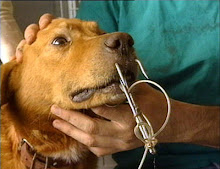U of M researchers identify gene linked to common ailment in labrador retrievers
Researchers at the University of Minnesota College of Veterinary Medicine have identified a gene in Labrador retriever dogs highly associated with the syndrome of exercise-induced collapse (EIC). After intense hunting or retrieving exercise, activities these dogs are trained to perform, affected Labradors start to lose control of their hind limbs. In most cases, their legs get wobbly and the limbs give out, and in rare cases the dogs may die. Labradors are the most common dog breed in the world and an estimated 3-5 percent of Labradors have this condition. The research is published in the journal Nature Genetics.
The research team identified a mutant form of the dynamin 1 gene as highly associated with EIC. The dynamin 1 protein normally functions to maintain proper chemical communication between adjacent nerves, also known as synaptic transmission. However, the mutated form of the dynamin protein appears to have diminished function, interrupting synaptic transmission during intense exercise, and causing the muscle-controlling nerves to not fire when directed to do so.
"This is very exciting because it is the first naturally occurring mutation of this gene identified in any mammal," said James Mickelson, Ph.D, professor of veterinary sciences at the University of Minnesota and co-principal investigator on the study. "Its discovery could offer insight into normal as well as abnormal neurobiology in both animals and humans."
Researchers also determined that up to 30 percent of Labrador retrievers are carriers of the mutation, and they developed a genetic test to indicate whether dogs have the normal or mutated forms of the gene.
"The test can not only help confirm the diagnosis, but it can also help dog breeders ensure that no dogs inherit two copies of the mutated gene," said Edward "Ned" Patterson, D.V.M, Ph.D., assistant professor of veterinary medicine at the University of Minnesota and co-principal investigator of the study.
Owners can have their dogs tested through their veterinarian by submitting a blood sample to the University of Minnesota Veterinary Diagnostic Laboratory. Breeds such as Chesapeake Bay and curly-coated retrievers, which are closely related to Labradors, have also been found to have the dynamin 1 mutation. The research team is now determining what other breeds might be involved and more precisely defining the specific alteration in dynamin function.
###
The University of Minnesota research team was led by Patterson Mickelson and included Katie Minor, B.A., R.N; Anna Tchernatynskaia, M.S; and Kari Ekenstedt, D.V.M. Additional members are Susan Taylor, D.V.M., from the Western College of Veterinary Medicine at the University of Saskatchewan, and G. Diane Shelton, D.V.M, Ph.D., from the University of California San Diego School of Medicine. Shelton and Taylor have investigated EIC for the last 13 years in an attempt to determine whether the problem was muscular, cardiovascular, or neurological. Suspecting the syndrome had a novel genetic basis, Shelton and Taylor collaborated with the University of Minnesota researchers in 2001.
The research was funded by the Morris Animal Foundation and the American Kennel Club Canine Health Foundation.
Contact: Molly Portz
mportz@umn.edu
612-625-2640
University of Minnesota
Sunday, September 21, 2008
Subscribe to:
Post Comments (Atom)




No comments:
Post a Comment